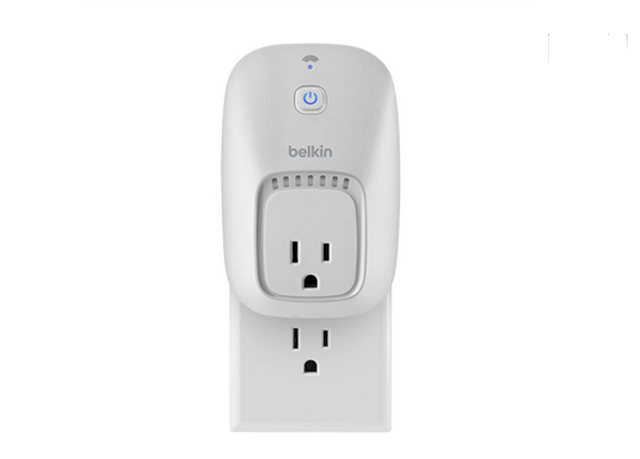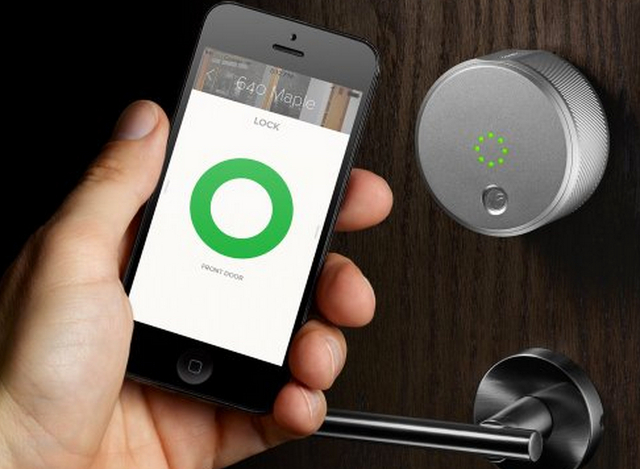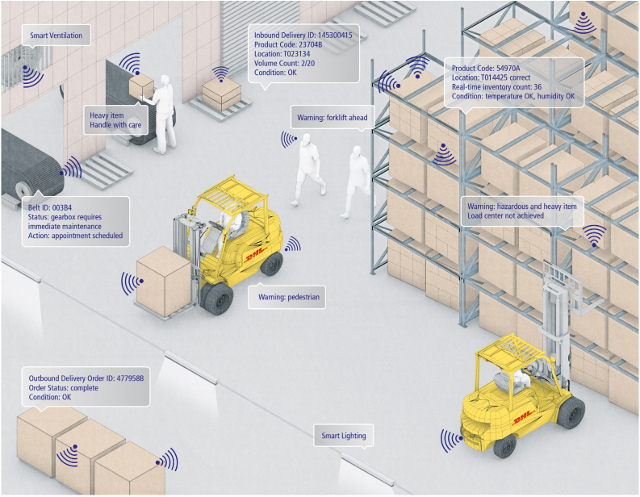15 Examples of Internet of Things Technology in Use Today
[the_ad id='1307']
One of the most common buzzwords in technology circles right now is “Internet of Things” (IoT). People are talking about it all over the place, from the newspaper to tech blogs—but what, exactly, is the IoT? It can be tough to wrap your head around without seeing examples of the technology in action. So here are 15 examples of IoT technology that are in use today.
Top Examples of Internet of Things Technology in Use Today

One of the most highly visible and popular pieces of Internet of Things technology is the Nest, a smart thermostat that’s connected to the internet. The Nest learns your family’s routines and will automatically adjust the temperature based on when you’re home or away, awake or asleep, hot or cold, to make your house more efficient and help you save on heating and cooling bills. The mobile app allows you to edit schedules, change the temperature when you’re away from home, and even receive alerts when it looks like something has gone wrong with your heating or cooling system.

One of the most useful devices in the Belkin’s range of WeMo connected home devices in the Switch, a smart plug. It plugs into a regular outlet, accepts the power cord from any device, and can be used to turn it on and off on a set schedule or when you hit a button on your smartphone. Another model of smart plug, the Insight switch, also monitors how much energy your devices are using, helping you make your home more energy-efficient. You can see when the plugs are on, how much power they’re using, and set schedules for operation right from the mobile app.
The Philips Hue lighting system is the most popular of the smart bulbs currently available. What can a smart bulb do that a regular one can’t? For one, it can change colors—the Philips Hue lights can change to any color you choose; they’ll even match the tones in a photo that you upload via the app. They can also be turned on and off on a schedule or from your smartphone, and the Hue bulbs can even be synced with your music for an awesome sound-and-light party. Other companies are starting to release smart bulbs as well, making this a more competitive niche; LIFX, Lumen, ilumi, and Belkin all have their own version of this technology. Like most other IoT smart home devices, these can help you save money on energy—as well as have a lot of fun playing around with your lights.

With this smart lock, you’ll never need keys again—it unlocks automatically when you get home, and locks behind you when you close the door. You can grant guest keys to friends or the dog sitter, and have them expire when you no longer want to give that person access to your house. An optional keypad means you can set a code to open your door in case you don’t have your phone with you (like if you’re out for a run). You can even view the activity log and grant access from your smartphone remotely. Smart security systems are becoming more popular with the increase in options, and a smart lock like this one is a great place to start.
In the past, a motion detector was about the most advanced device that you could use to secure your home against intruders—but today’s home monitors are much more advanced. For example, the Canary combines video, audio, motion detection, night vision, a siren, and air quality, temperature, and humidity sensors into a single device that you can control from your phone. Piper is a similar system that serves as a security system and a home monitoring device, and it can also serve as a speaker, letting you speak to anyone in your home even if you’re away. These systems are pushing the boundaries of how in control you can be, regardless of where you are in relation to your home.
Not all smart home devices are single pieces of equipment—there are entire systems that you can use to automate your home. For example, the SmartThings system lets you control lights, locks, plugs, thermostats, cameras, and speakers from a central hub that you can access from your smartphone, as well as a wide range of sensors that you can use with the Smartthings system to create a security solution that’s integrated with all of the other electronics in your home. There are very few home electronic devices that you can’t control with Smartthings or another hub-based smart home system, like Logitech’s Harmony or the Lutron Smart Bridge.
Of course, the IoT extends to things that are much smaller than an entire smart home setup. A great example of this is Kolibree, the smart toothbrush. Kolibree connects to your smartphone and encourages good brushing habits for both kids and adults by turning brushing into a game and saving data on your phone about your brushing habits. The Kolibree doesn’t yet transmit this data to your dentist, but don’t be surprised if that becomes an option!
Why should humans be the only ones to benefit from the Internet of Things? Petnet’s smart feeder helps you calculate the best type of food for your dog or cat, how much they should be eating, and even sets up delivery of pet food for when you run out. You control the smart feeder via your smartphone, and can monitor your pet’s food consumption even if you’re away from home.
Have you ever wished that you could have a café-grade coffeemaker built into your kitchen? With the Topbrewer, you can—and not only do you get access to top-quality coffee whenever you want, but you can also make it from anywhere with the companion app. Choose the type of drink you want—latte, Americano, mocha, cappuccino, juice, hot chocolate, even carbonated water—and all you need to do is hit “Start Now” to kick off the brewing. And it’s fast: the Topbrewer only takes 15 seconds to make a filter coffee. If you’re a coffee fanatic, you may want to start saving; the Topbrewer will run you over $10,000.
Healthpatch Health Monitor

Most of the Internet of Things devices we’ve discussed so far have been for your convenience—you could use normal bulb, you could set up a security system, and you could have your neighbors feed your pet. But the Healthpatch serves a greater purpose than your convenience. It can be used for out-patient care by healthcare providers, letting them get ECG, heart rate, respiratory rate, skin temperature, body posture, fall detection, and activity readings remotely. This can alert doctors to potential health problems before they arise, or give them additional insights into which treatments will be most effective for their patients, even when their patients aren’t in the office.
Similar to the Healthpatch, the Lively system aims to help people who may have medical problems. The central hub connects to a smartwatch that will indicate to family members that the wearer might need help. It also enables the wearer to alert their family or an ambulance that they require assistance in case of a fall or other mishap. Passive sensors placed around the home can also track activity, enable medication reminders, and send out alerts for things like missed meals or decreased physical activity. The Android app even lets monitoring continue when the wearer is away from the hub. IoT products like the Lively system are helping more seniors live independent lives instead of requiring in-patient or assistive care.
Until now, the examples of Internet of Things devices have focused on the home—but the IoT reaches far beyond the walls of your house. The Automatic app, for example, tracks information about your car by using an in-car adapter. It keeps track of things like mileage, hours driven, fuel cost, fuel efficiency, location, and ignition status. It can be connected with other apps, too, making it even more useful. Dash is an alternative to Automatic that gives you similar information, and calculates an overall “Dash score” to help you improve your driving. Many fleet vehicles are now getting IoT capabilities so they can be monitored and made more efficient, as well.

On a very large scale, the Internet of Things can help a great deal with logistics. For example, DHL provides shipping, warehousing, distribution, and supply chain management all over the world, and this requires a huge amount of communication. DHL released a report detailing some potential uses of IoT technology that includes vehicle monitoring and maintenance, real-time tracking of packages, environmental sensors in shipping containers, information-gathering on employees and tools, and a number of safety-enhancing features for vehicles and people. While it may take a while for all of these kinds of technologies to emerge, the efficiency of logistics and shipping could be significantly increased if they work as expected.
Cisco, a leader in the IT field, is encouraging companies to make their manufacturing and production processes more efficient by integrating IoT technologies in their plants. Remote monitoring and access to the equipment used in manufacturing could greatly improve efficiency, allow issues to be resolved more quickly, and, in the end, result in production being increased. While most people will never see these benefits, stakeholders and businesspeople will likely to become more interested in these types of technologies over time, as the return on investment becomes more clear.
When you think about it, cement seems like one of the least “smart” things out there—you pour it, it becomes rock-hard, and that’s that. But Oceanit Laboratories (along with other research companies) is trying to change that by embedding nanosensors in the material, allowing it to “[behave] more like a sensor, capable of transmitting and responding to mechanical, acoustic and magnetic signals.” They give the example of oil drilling; the cement surrounding a well could pass information back to workers, helping them understand the integrity of the well and better assess risk. There are many conceivable uses for this technology, from sidewalks to hydroelectric dams.
SEE ALSO: 30 Cool Inventions You Should Know About
Changing the World, One Thing at a Time
The Internet of Things is a fascinating field, and connecting everyday devices to the internet can be hard to wrap your head around at times. But with the technologies above, and the others being researched and released every day, we’re moving toward a future where devices are smarter, we’re more in control, and we’ll be able to leverage technology to create more efficient, intelligent machines. And what’s there not to like about that?
[the_ad id='1307']
Source link
[the_ad id='1307']
